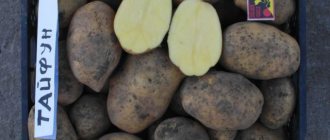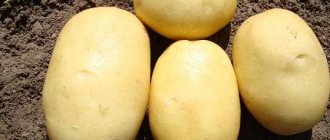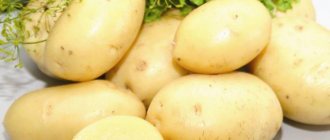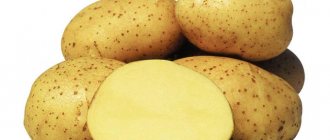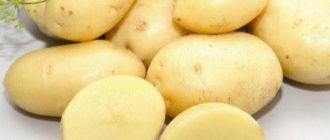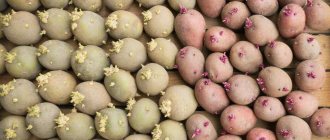Azhur is a young variety that was bred to replace some European varieties of potatoes. It is rapidly gaining popularity among gardeners, as it has an attractive appearance and excellent taste. And the result of the work can be assessed already in July.
Description
Azhur is a mid-early table variety that produces a good harvest. From the moment of sprouting until the potatoes are fully ripened, 75-85 days pass. But you can start digging it 20-25 days earlier.
The plant forms a spreading, vigorous bush that can reach up to 45-55 cm in height. Large, dark green leaves grow unevenly on it. They have a wrinkled structure and a slightly wavy edge. At the top of the bush there are inflorescences of large, light lilac flowers.
Azhur tubers are medium in size and oval in shape. The thick peel is dark pink. The surface of the potato is smooth, the eyes are small and shallow. The pulp contains a large amount of carotene, so it has a straw color. The taste is rich, with a pronounced aroma.
The mass of tubers is in the range of 100-120 grams. One bush can produce 8-15 root crops. On average, gardeners receive 45-50 tons of harvest from one hectare. Small potatoes are rare; almost all potatoes are the same size.
Potatoes of this variety are characterized by a high starch content (about 14-16%), so they are widely used in cooking. Ideal for frying, preparing salads and soups.
Attention! After cooking, the flesh does not darken.
Advantages and disadvantages
Potatoes of this variety are very young, but promising. Openwork is characterized by a number of advantages:
- Early maturation. Potatoes for food are dug up at the end of June - the first half of July.
- Excellent presentation and taste. Suitable for sale.
- High yield.
- The keeping quality of root crops is 95%. If favorable conditions are created, potatoes of this variety can be stored for a long time without spoiling.
- It tolerates drought well and does not require frequent watering.
- Unpretentious to soil composition.
- It is not affected by potato cancer and scab, and has average resistance to late blight.
The disadvantages of the Azhur potato include its susceptibility to the golden nematode. Plantings are often attacked by Colorado potato beetles, wireworms and moths. To prevent diseases, it is recommended to treat bushes with special preparations. Young tubers are subject to mechanical damage, as they have thin and delicate skin.
Landing
Potatoes of the Azhur variety are planted in April-May, when the earth warms up to +12 degrees. It is not advisable to delay the landing. High or low air temperature has a negative effect on tuber germination. Potatoes are planted on a flat, well-lit area. The best crop predecessors are winter crops and legumes. Planting potatoes of the Azhur variety should not be located next to tomatoes and apple trees.
In autumn, humus or peat is added to the site at the rate of 1 bucket per 1 m2. Mineral fertilizers are also added: superphosphate, potassium sulfate and wood ash. After applying fertilizers, the soil is disinfected, dug up and weeds are removed. There is no need to break the lumps. In spring, the ground is loosened and leveled with a rake. The procedure facilitates access of water and air to the roots of the plant.
Attention! Fresh manure should not be used for fertilizer. Otherwise, the tubers will be watery and tasteless.
15 days before planting, Azhur potatoes begin to germinate. Tubers are sorted and diseased and damaged ones are discarded. They are then cleaned and washed, as bacteria may remain in the soil. The selected seed material is disinfected in a solution of boric acid (1 tablespoon of powder per bucket of water). To activate growth processes, tubers are sprayed with a solution of potassium permanganate (2 g per 10 liters of water) or infusion of ash (2 cups per 4 liters of water). The potatoes are dried and put in a bright place. The air temperature in the room should be from +12 to +16 degrees.
Azhur tubers are planted in holes or grooves to a depth of 5-10 cm. The interval between bushes should be about 25 cm, and between rows - 55-60 cm. If fertilizers were not applied during autumn digging, they should be poured separately into each hole. This potato variety loves potash fertilizers.
Reviews
Gardeners rate this potato positively, giving it good reviews:
- Alexey from Ryazan is simply delighted with the variety. Having planted only 10 tubers, he collected 20 large root crops from each bush. I really liked the potatoes and their excellent taste.
- Marina from Ivanovo and her family also liked the Azhur variety for its good yield, large tuber size and excellent taste. It was noted that these potatoes grow better in loose soil and respond well to fertilizing.
Potato Azhur was created to replace the previously popular European varieties of this crop. And today it is widely used both for small personal gardens and for industrial plantings. And since this variety is unpretentious, it is perfect for those who will plant potatoes for the first time.
Care
Potatoes of the Azhur variety are unpretentious, so it is enough to provide them with minimal care. It includes hilling, watering, loosening and weed removal.
Watering and loosening
Despite the fact that this variety tolerates a lack of moisture well, in dry and hot summers watering will only be beneficial. Irrigation is carried out during the period when the sun is least active - in the early morning or late evening. On average, about 45-50 liters of water are required per 1 m2. Typically, the crop is irrigated once every 10-14 days, and during drought every 4-5 days. If there is sufficient rainfall, you can limit yourself to three waterings per season.
A few days after irrigation, the soil must be loosened, otherwise a crust will form on the surface of the earth. Gardeners also recommend mulching between rows. The procedure will help retain moisture and prevent the appearance of weeds.
Hilling
Potatoes of the Azhur variety require at least two hillings with an interval of 21 days. In some cases, the number of procedures can increase up to four times. Work is carried out in cloudy weather, and the ground should be wet.
The bushes begin to earth up when they grow to 8-12 cm. Repeated earthing up is carried out when the shoots reach 25 cm in height. But before the planting procedure, they are cleared of weeds.
Important! During flowering of potatoes, hilling should be carried out carefully, since tubers are formed during this period. Any careless action may damage them.
Top dressing
The Azhur variety has a positive attitude towards fertilization. In order to achieve the desired effect, potatoes need to be fed at each stage of their ripening. After germination, organic matter is added to the soil. Manure or bird droppings are diluted in water in a ratio of 1:15 and infused for two days.
Before flowering, potatoes are fertilized with a solution of 1 tbsp. l. potassium sulfate, 3 tbsp. l. wood ash and 10 liters of water. Some gardeners prefer to spray the bushes with a urea solution (300 g per 10 liters of water).
During the flowering period, both mineral and organic fertilizers can be added to the soil. You can use the following composition: two tablespoons of superphosphate, a bucket of water and mullein.
Features of cultivation
As for agricultural technology, this potato tolerates any soil, but prefers light, fertile soil. Productivity increases with moderate application of mineral complex fertilizers. Complexes with a high nitrogen content should be avoided; they promote abundant growth of tops to the detriment of tubers.
Read more about how to feed potatoes, when and how to apply fertilizers, and how to do it correctly when planting.
Tip: For planting, medium-sized root crops that are not damaged by pests are selected. They are pickled, treated with growth stimulants and germinated in the light or in sawdust.
Planting begins in the second half of May, when the soil has completely warmed up. In warmer regions, tubers can be planted earlier.
Before planting, the soil is thoroughly loosened, and plant remains that can become a breeding ground for bacteria and insect larvae are selected from it. For greater safety, the soil can be treated with disinfectants and mulched.
Every three years, planting areas need to be changed to avoid infection. It is better to plant potatoes on land that was occupied by legumes, cabbage, carrots, and meadow grasses.
The tubers are planted with a depth of 10 cm, the distance between the holes is 30-35 cm. Row spacing is left 70 cm wide. Humus and wood ash can be spread over the holes, which increases the nutritional value of the soil.
During the planting season, they hill up 2-3 times, forming high ridges above the bushes. Watering is recommended, as well as a one-time application of fertilizers. 10 days before harvesting, the bushes can be sprayed with an aqueous solution of superphosphate. Foliar feeding allows you to increase the weight of tubers, preventing them from accumulating nitrates.
The tubers have a thin but durable skin that is not damaged when digging. For industrial cultivation, you can use combines with direct or side grip. The collected potatoes are sorted and dried at the boundary or under a canopy. Potatoes intended for sale can be packed directly in the field.
We bring to your attention some more interesting materials about methods of growing potatoes. Dutch technologies, harvest without weeding and hilling, growing early varieties, as well as harvesting from seeds, under straw, in barrels, in boxes, in bags.
Diseases and pests
The Azhur variety is resistant to potato cancer and scab. But it can be affected by golden nematode and late blight.
The photo shows a potato affected by the golden nematode.
Let's look at the most common diseases of Azhur potatoes in the table:
| Disease | Signs | Control measures |
| Golden nematode | The bushes turn yellow and lag behind in development. The foliage dries and curls. Many adventitious roots are formed. The tubers are small. | The infected plant is dug up along with a lump of earth and destroyed. Planting potatoes is alternated with rye, beans, marigolds and calendula. In case of severe damage, chemicals are used - thionazine. |
| Late blight | The appearance of brown spots on leaves and stems. At high humidity, a white coating forms. Depressed spots are found on Azhur potato tubers. | Chemical preparations used include Quadris, Ridomil Gold or Bordeaux mixture. From biological ones - Trichodermin or Fitosporin. The plant is sprayed according to the instructions. |
| Alternaria blight | Dry, brown spots appear on leaves and stems. The tubers are covered with large depressed spots. | Before planting, the tubers are sprayed with Integral or Bactofide. During the growing season, the following drugs are used: Profit, Abiga-Pik, Thanos, Novozri and Metamil. |
Among the pests, Azhur potato bushes are usually affected by Colorado potato beetles, wireworms, mole crickets and moths. The most effective drugs against them are Aktara, Prestige, Corado and Regent.
How to care for potatoes?
Care of crops depends on the planting method. But any of them includes:
- watering;
- hilling;
- fertilization;
- pest control.
Important! Potato tubers that have received excessive sun exposure become green. It's a plant poison
—
solanine It can lead not only to poisoning, but also to death. Green areas on potatoes must be cut off.
Irrigation mode
The frequency of watering depends on how quickly the soil loses moisture. Sandy soil is watered more often - 2 times a week. Mulching will help improve the situation. Covering materials, sawdust, straw or others, will prevent the soil from quickly drying out and compacting. The clay area is watered once a week.
Watering before flowering is necessary in order to create optimal conditions for the growing season. During flowering, tubers are formed and watering is also necessary. But when the bushes stop growing and the stems begin to wither, irrigation is stopped.
Watering rules:
- Do not water until the first hilling. This promotes wider development of the root system.
- Do not water deeper than 40 cm (there are no potatoes there).
- Ensure uniformity of watering.
Did you know? In the 19th century, potatoes in Alaska became the only remedy that prevented scurvy among gold miners and could be stored for a long time. The price of tubers was so high that it was equal to the cost of gold.
Feeding
Immediately after germination, the above-ground part of the plant begins to develop. At this stage, you need to intensively supply the plant with water and nutrients. Then the root system begins to form.
Substances necessary for potatoes:
- nitrogen - to stimulate growth, increase the number of leaves and enhance photosynthesis;
- phosphorus - to accelerate the growth of the root system;
- potassium - to stimulate the growth of roots and leaves, regulate water balance and metabolism.
The first feeding is carried out 2 weeks after planting. To do this, choose a fertilizer with equal parts of nitrogen, phosphorus and potassium in it. The rate of application of inorganic fertilizers is 7 kg of fertilizers per 300 m² of land. Continue fertilizing every 4 weeks and stop 2 weeks before harvest.
Read more about how and how to properly process potatoes.
Weeding and loosening the soil
Removing weeds leaves more nutrients for the tubers and makes harvesting easier. The fight against them is combined with loosening the soil and hilling - increasing the embankment around the potatoes. The purpose of hilling is to increase the volume of the root system and, accordingly, increase the number of tubers.
The procedure is carried out using any planting method, starting from the moment the stems reach a height of 10–15 cm, that is, approximately 2 weeks after planting. The second hilling is carried out during flowering. It is believed that tuberization occurs precisely at this moment. But this statement is not true for all varieties. After the potatoes have flowered, hilling is not carried out.
Did you know? The heaviest potato in the world weighed 4.98 kg. This is enough to make 70 servings of French fries.
«
McDonald's
»
.
Preventive treatment against diseases and pests
Potato diseases manifest themselves in the form of spots on the leaves, plaque, and wilting of the foliage. Viruses and bacteria enter plant tissues due to mechanical damage or damage by pests.
Main potato diseases:
- Bacterial wilt or brown rot is the most serious bacterial disease. It begins with yellowing of the leaves. Then they darken and dry out, and white mucus appears on the stems. Compliance with the rules of crop rotation is considered an effective countermeasure.
- Potato blackleg and soft rot of tubers spread in warm and humid weather. The lower part of the stem is affected first, and then blackness and wilting move upward. Controlling humidity and avoiding overwatering is the main way to prevent the disease.
- Ring rot is a recurrent disease problem in temperate climates. Symptoms usually appear mid-season or later and include stem wilting. The plant becomes lethargic and brown rings are visible on stem sections. Prevention is the use of varieties resistant to the disease.
- There are several types of potato scab Its main signs are brown and hardened spots on tubers, covered with cracks. Prevention - planting disease-resistant varieties. Azhur is one of these.
- Late blight affects potato tops after flowering. Appears as dark spots on the leaves. Affected stems quickly wither. When the first signs of the disease appear, they are sprayed with Ridomil and Fitosporin.
- Leaf chlorosis , or yellowing of leaf blades, appears in the second half of summer and is not a disease, but rather a symptom of nutrient deficiency. As a treatment, spraying the bush with iron sulfate is used.
The main ways to combat diseases are: selection of varieties that are resistant to fungal infections, treatment of planting material with Fitosporin or another drug that disinfects tubers, as well as compliance with crop rotation.
Like other plants, potato crops are attacked by pests. Hilling is an effective method of controlling leaf pests, since it removes most of the leaf mass under the ground.
Main potato pests:
- The Colorado potato beetle is the most common pest and feeds on leaves. The beetle is inedible for birds, so in small areas of potato beetles and their larvae are collected by hand, shaking them into a special container. Among chemical agents, it is recommended to use the preparations “Aktara” and “Prestige”.
- Caterpillars are the larvae of various butterflies, including potato cutworms and leaf beetles. Larvae that damage tubers can also be dangerous. The drug “Zolon” will help fight caterpillars.
- Wireworms are the larvae of click beetles that damage tubers. Among the environmentally friendly but effective ways to combat them is to plant mustard next to the potatoes. Its essential oils are toxic to wireworms and force the pest to leave the area.
- Nematodes are microscopic worms that live in both tubers and leaves. To combat them, treat the soil with boiling water to a depth of at least 20 cm. Also, the tubers and soil are treated with the drug “Karbofos”.
- Aphids attack potatoes less frequently than other crops. These green little insects feed on the sap of leaves. Their vital activity weakens plants, and the sticky coating left by aphids serves as a breeding ground for sooty fungi. The crops are treated against the pest with a solution of insecticidal soap, and insect predators are also attracted to the area. Thus, one ladybug can eat about 5,000 aphids in its life.
- Thrips are thin, elongated insects that feed on sap. Their populations increase when dry and warm weather sets in, so the best way to control them is to moisten the potato crops.
When using chemical methods of insect control, spraying is carried out with a complex preparation or a remedy for a specific pest. The choice often depends on the preference of the farmer. When using any drug, be sure to follow the instructions for it.
Harvesting
Early potatoes for food are dug up at the end of June - the first half of July. During this period, the bushes fade and the foliage withers. The ripened crop is harvested in August. Potatoes are fully ripe when the tops wither. When harvesting, carefully dig up the bush with a pitchfork and pull it out by the tops.
Before storage, the tubers are sorted out, rotten and diseased ones are thrown away. Then the potatoes are put into the cellar or into a special pit lined with boards. The air temperature should be from +2 to +4. If it is higher, the tubers will sprout. Potatoes of the Azhur variety can be stored for a long time.
History of the variety's creation
The history of potatoes began during the reign of Peter I. At that time, there was even a “potato riot”, where people stubbornly refused to grow and eat an unfamiliar vegetable brought from Holland, to which the king responded with cunning. Instead of forcing the peasants, he placed guards near the fields where potatoes grew, and removed them at night. Thus, it aroused curiosity among people who always preferred to try the forbidden fruit. Now potatoes are widely grown throughout Russia.
As a result of experiments on potatoes, more and more new varieties began to appear, one of which was the Azhur Elite seed potato. Compared to other varieties, this is a completely young vegetable. It was bred in Russia, and in 2021 it was entered into the state register of the Russian Federation. The variety was developed by the agricultural company Sedek.
It is recommended to grow the vegetable in the central regions of the country. This includes areas such as:
- Moscow;
- Ivanovskaya;
- Vladimirskaya;
- Ryazan;
- Kaluzhskaya;
- Bryansk.
Since the variety ripens early, it can be harvested as early as July, which in the southern parts of Russia allows for two harvests per year. What the Azhur variety of potatoes is, the description of the variety will tell gardeners in detail.
